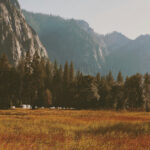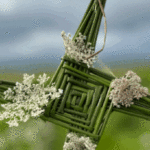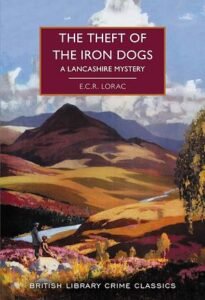
![]()
The Theft of the Iron Dogs: A Lancashire Mystery
E.C.R. Lorac
“The harvest moon was just past the full, and it seemed to sail overhead in a sea of luminous iridescence, due to the vaporous clouds in the high steely vault of the sky.”
While checking on their riverside cottage at the end of the harvest season, retired bookseller Giles Hoggett notices something odd. The woodpile is disturbed, something has been burned on the hearth, and several items are missing from their usual spots. Normally a lightly-burgled cottage in the wilds of Lunesdale would be of little interest to Scotland Yard; however, Chief-Inspector Robert Macdonald’s pleasant associations with the place give him an excuse to visit. Little does either man know the depth of the mystery they’re about to encounter.
What a lovely read! Originally published in 1946, this is a classic cozy mystery: bloodless/off-screen murder in an idyllic setting populated with grumpy farmers, and not a bit of magic in sight. Lorac (pen name of Edith Caroline Rivett) sets the scene beautifully, filling the pages with descriptions both delightful and heartbreaking. Hoggett and Macdonald make a great team, and the mystery kept me on my toes. The cast of characters was a bit large, but things came together nicely at the end.
Give this one a try if you like true classic coziness. And good news: if you like this one there’s 45(!) more in this series. Read in any order at your leisure.
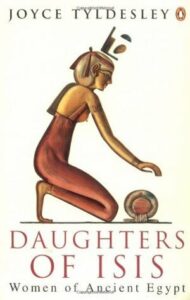
![]()
Daughters of Isis: Women of Ancient Egypt
Joyce Tyldesley
“Egyptian daughters therefore looked forward to leading a life very similar to that led by their mother and grandmothers before them, interpreting this continuity as a sign that Egypt, and therefore the world, was functioning correctly.”
While similar in many ways to their Roman and Greek counterparts, the lives of ancient Egyptian women gave them more freedom in both the private and public spheres. Tyldesley’s book uses contemporary art, documents, and codes of law to shed light on womens’ roles in — and impact on — religion, family, and daily life.
Books like this drive me crazy because they remind me how frustratingly little we know about women’s lives. They were considered less important, so fewer men wrote about them; they weren’t taught to read or write, so they couldn’t even leave their own records. Tyldesley is a well-regarded Egyptologist and archaeologist, but so much of what even she “knows” about ancient women is based on inference, reading between the lines, and sometimes pure guesswork. Additionally, this book was published in 1994 — its age is showing (I haven’t seen the word “transvestite” in research-based non-fiction in a long time) and I wish there was an updated edition that covered all the things the author says are being revisited and reinterpreted.
Probably (hopefully!) outdated by now, but still an interesting read.
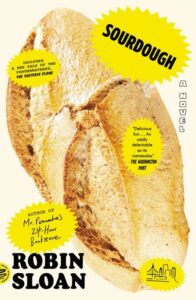
![]()
Sourdough
Robin Sloan
“I have come to believe that food is history of the deepest kind. Everything we eat tells a tale of ingenuity and creation, domination and injustice — and does so more vividly than any other artifact, any other medium.”
Lois’ job at a sleek San Francisco startup is lucrative, but it may be killing her. The only thing that seems to help is the spicy soup and sandwiches crafted by a couple amateur restaurateurs living a few streets over. When the pair has to leave the country, their parting gift is unexpected: the sourdough starter they use to craft their curiously delicious bread. Soon her new roommate is feeding Lois, her upstairs neighbor, and a handful of co-workers. But it’s only when Lois is encouraged to audition her sourdough for the local (highly competitive) farmer’s market that things start to get really interesting.
This book was recommended to me last year by my mother-in-law and sister-in-law; based on the publisher’s blurb I went in expecting a cozy book about how baking brings the main character to a found family. What I did not expect was magical realism mixed with whimsy, social commentary, and a heaping spoonful of what-the-hell-is-happening. And I…kinda loved it? I wish it had been a book club selection or buddy read because there’s tons to discuss about Lois’ journey and what she learns. Odd, interesting, lovely, and fun.
Pick this up if you like weird little books that make you think.
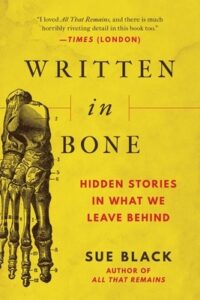
![]()
Written in Bone: Hidden Stories in What We Leave Behind
Sue Black
“Our bones are the scaffold for our bodies and they survive long after the skin, fat, muscle and organs have dissolved back into the earth. They are designed to be robust, to hold us upright and to give us form, so it is logical that they should be the last sentinels of our mortal life to bear witness to the way we lived it.”
It’s been said that flesh forgets but bones remember; this is obvious to one more than forensic anthropologists. From the top of our skull to the tip of our smallest metatarsal, our bones can tell how we lived and died — if the person who finds them knows what to look for.
This book sits right at the intersection of science and true crime, and I’m happy as a clam to be here. Black is an excellent storyteller, nicely balancing the biology with real-life examples of cases where bones helped tell the story of the victim, how they lived, or how they died. She does this with a touch of humor, a clear sense of respect for the dead, and a strong moral compass. A solid mix of education and entertainment.
Add this to your TBR if you like science, history, and true crime (just be ready for that last chapter — it’s a doozy!).
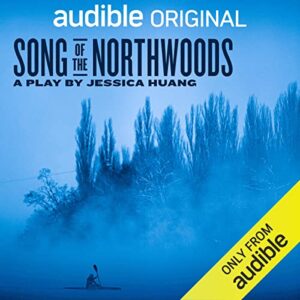
![]()
Song of the Northwoods
Jessica Huang
With her career officially on hold, Song Kuan has retreated to her friend Lucy’s family cabin in rural Minnesota. Her plan is to focus her energy on the cold case podcast she and Lucy started together. But when an anonymous tip from a listener points them toward a cold case in the area, the usually friendly locals — including Lucy — clam up. Song is determined to solve the mystery, but there may be someone else just as determined to keep the secret.
I enjoy the occasional full-cast audiobook and am always down for a mystery, so when this rolled by on Audible I was excited to dive in. It started off well enough, but the logic and plot fell apart pretty quick. The run time was short, less than two hours; I wonder if making it longer would have given the author more time to develop the characters and plot lines. Disappointing overall.
If you’re looking for a similar vibe but with significantly better execution, I recommend checking out Limetown.
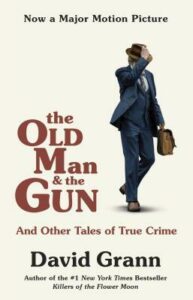
![]()
The Old Man & the Gun: And Other Tales of True Crime
David Grann
“Just before Forrest Tucker turned seventy-nine, he went to work for the last time.”
A septuagenarian bank robber. A Polish writer who may have included the murder he committed in his novel. A serial con man who’s not in it for the money. Three stories about three fascinating criminals told by a master of narrative non-fiction.
I added David Grann to my auto-read list last year, so of course this means I need to go through his backlist as well. These stories are wild, and further evidence that truth is stranger than fiction. Grann does a great job incorporating the facts while also exploring the psychology and motivations of his subjects. I never like short stories as much as I want to because I always want more; fortunately for me, these three stories are actually excerpts from a larger collection of Grann’s stories, The Devil and Sherlock Holmes.
Read this if you like true crime and excellent narrative non-fiction.
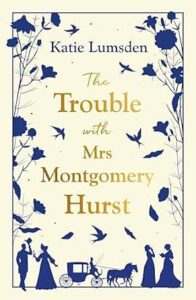
![]()
The Trouble with Mrs. Montgomery Hurst
Katie Lumsden
“…and when the dance finished, each went off to whisper to their parents, to their siblings, to their friends, that Mr. Montgomery Hurst was to be married. They were not quite sure to whom, but they did know that his bride was not to be Miss Ashpoint.”
If it is a truth universally acknowledged that gossip and secrets make the best currency, the inhabitants of Wickenshire may be the wealthiest in England. But with that “wealth” comes risk: discovery, scandal, a livelihood or reputation ruined. For Amelia Ashpoint, the surprise marriage of her supposed suitor may be the least of her worries.
Normally being bamboozled by a publisher’s blurb would irritate the fire out of me, but I’m making an exception in this case because the book was so much more and better than described. Rather than being the main focus, the titular Mrs. Hurst acts as a catalyst for much of the action. The novel is clearly an homage to Jane Austen, but contains subplots and commentary that makes it feel more realistic and less rosy. The characters were interesting, and there was a great mix of biting wit and bittersweetness. It earned every one of its five stars.
Try this if you love a character study masquerading as an Edwardian novel.
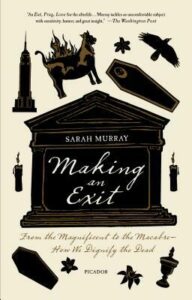
![]()
Making an Exit: From the Magnificent to the Macabre — How We Dignify the Dead
Sarah Murray
“The way we deal with the dead speaks volumes about the human race. Death rites and grave sites are the focus for astonishingly diverse forms of expression.”
When journalist Sarah Murray’s father dies, she has to find a way to honor his wishes while also celebrating his life. Processing his mortality makes her consider her own, and she embarks on a journey to investigate how cultures worldwide honor their dead. From fire-filled spectaculars in Bali to ossuaries in Europe — and everything in between — Murray explores what it means to be human, what it means to die, and how we matter to those we leave behind when we go.
If pressed to summarize my favorite things to read about, I’d wager that my family and book club pals would say something like, “Weird, interesting, or bad stuff happening to a human body.” This book has the first two in spades. I’m endlessly fascinated by how different cultures treat their dead, and appreciated that several of Murray’s chapters focused on places I don’t know much about (although I have been to the Sedlec Ossuary — it’s strange and compelling but also did you know old bones really stink?). Between the historical context and descriptions of funerals/mourning Murray also includes a mini-memoir about her father, and her exploration of what she wants to happen when she dies. It’s a beautiful mix of history, science, tasteful irreverence, and love.
This is for you if you like history and—of course—weird or interesting stuff happening to a human body.
Photo by Joyce Hankins on Unsplash



